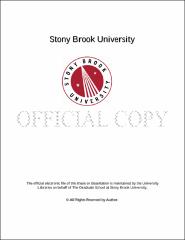| dc.identifier.uri | http://hdl.handle.net/11401/76355 | |
| dc.description.sponsorship | This work is sponsored by the Stony Brook University Graduate School in compliance with the requirements for completion of degree. | en_US |
| dc.format | Monograph | |
| dc.format.medium | Electronic Resource | en_US |
| dc.language.iso | en_US | |
| dc.publisher | The Graduate School, Stony Brook University: Stony Brook, NY. | |
| dc.type | Thesis | |
| dcterms.abstract | The purpose of this research was to study the interaction between chitosan and metal surfaces at the atomic level in order to better understand the mechanism of formation of catalytic noble metal nanoparticle (where chitosan serves as a shaping or encapsulating agent). In this study, Molecular dynamics (MD) simulation was employed to study chitosan adsorption on different Silver and Palladium crystallographic planes at the atomic level. Chitosan were formulated by molecular dynamics simulation named Materials Studio 6.0 using COMPASS force field. By calculated result of the solubility parameter δ , the length of chitosan was chosen 20 repeated units. Through MD simulation of chitosan chain, the result of the glass transition temperature of chitosan was similar to the experiment value as 476K.And the water content of chitosan was able to effect the glass transition temperature obviously as the water content increase that the glass transition temperature decrease. The interaction energy between chitosan and different metal surfaces indicates that the interaction of chitosan and silver (1 1 0) surfaces is stronger than that of (1 1 1) and (0 0 1) surface and the interaction of chitosan and palladium (1 1 0) surfaces is stronger than that of (1 1 1) and (0 0 1) surface. The concentration profiles show that hydrogen and amino groups of chitosan could form strong interactions with the surfaces of metal. The radial distribution function show that the probability of forming the nitrogen atoms and metal on the surface have physical interactions. This study provides useful information in understanding the interfacial interaction mechanism at the atomistic scale for polymer and metal. | |
| dcterms.available | 2017-09-20T16:50:05Z | |
| dcterms.contributor | Halada, Gary | en_US |
| dcterms.contributor | Gersappe, Dilip | en_US |
| dcterms.contributor | Raghothamachar, Balaji. | en_US |
| dcterms.creator | Wang, Wenbo | |
| dcterms.dateAccepted | 2017-09-20T16:50:05Z | |
| dcterms.dateSubmitted | 2017-09-20T16:50:05Z | |
| dcterms.description | Department of Materials Science and Engineering. | en_US |
| dcterms.extent | 76 pg. | en_US |
| dcterms.format | Monograph | |
| dcterms.format | Application/PDF | en_US |
| dcterms.identifier | http://hdl.handle.net/11401/76355 | |
| dcterms.issued | 2014-12-01 | |
| dcterms.language | en_US | |
| dcterms.provenance | Made available in DSpace on 2017-09-20T16:50:05Z (GMT). No. of bitstreams: 1
Wang_grad.sunysb_0771M_11885.pdf: 2100954 bytes, checksum: ac754ca4828a7df5df0a43af8e21fe62 (MD5)
Previous issue date: 1 | en |
| dcterms.publisher | The Graduate School, Stony Brook University: Stony Brook, NY. | |
| dcterms.subject | Chitosan, interface, Modeling, Molecular Dynamic | |
| dcterms.subject | Materials Science | |
| dcterms.title | Molecular Modeling of the Interaction between Chitosan and Silver and Palladium | |
| dcterms.type | Thesis | |

